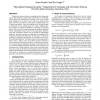Free Online Productivity Tools
i2Speak
i2Symbol
i2OCR
iTex2Img
iWeb2Print
iWeb2Shot
i2Type
iPdf2Split
iPdf2Merge
i2Bopomofo
i2Arabic
i2Style
i2Image
i2PDF
iLatex2Rtf
Sci2ools
131
click to vote
VISUALIZATION
1996
IEEE
1996
IEEE
Fast Perspective Volume Rendering with Splatting by Utilizing a Ray-Driven Approach
Volume ray casting is based on sampling the data along sight rays. In this technique, reconstruction is achieved by a convolution, which collects the contribution of multiple voxels to one sample point. Splatting, on the other hand, is based on projecting data points onto the screen. Here, reconstruction is implemented by an "inverted convolution" where the contribution of one data element is distributed to many sample points (i.e., pixels). Splatting produces images of a quality comparable to raycasting but at greater speeds. This is achieved by precomputing the projection footprint that the interpolation kernel leaves on the image plane. However, while fast incremental schemes can be utilized for orthographic projection, perspective projection complicates the mapping of the footprints and is therefore rather slow. In this paper, we merge the technique of splatting with principles of raycasting to yield a raydriven splatting approach. We imagine splats as being suspended in...
Perspective Projection | Raydriven Splatting Approach | Sample Points | Visualization | VISUALIZATION 1996 |
| Added | 07 Aug 2010 |
| Updated | 07 Aug 2010 |
| Type | Conference |
| Year | 1996 |
| Where | VISUALIZATION |
| Authors | Klaus Mueller, Roni Yagel |
Comments (0)

